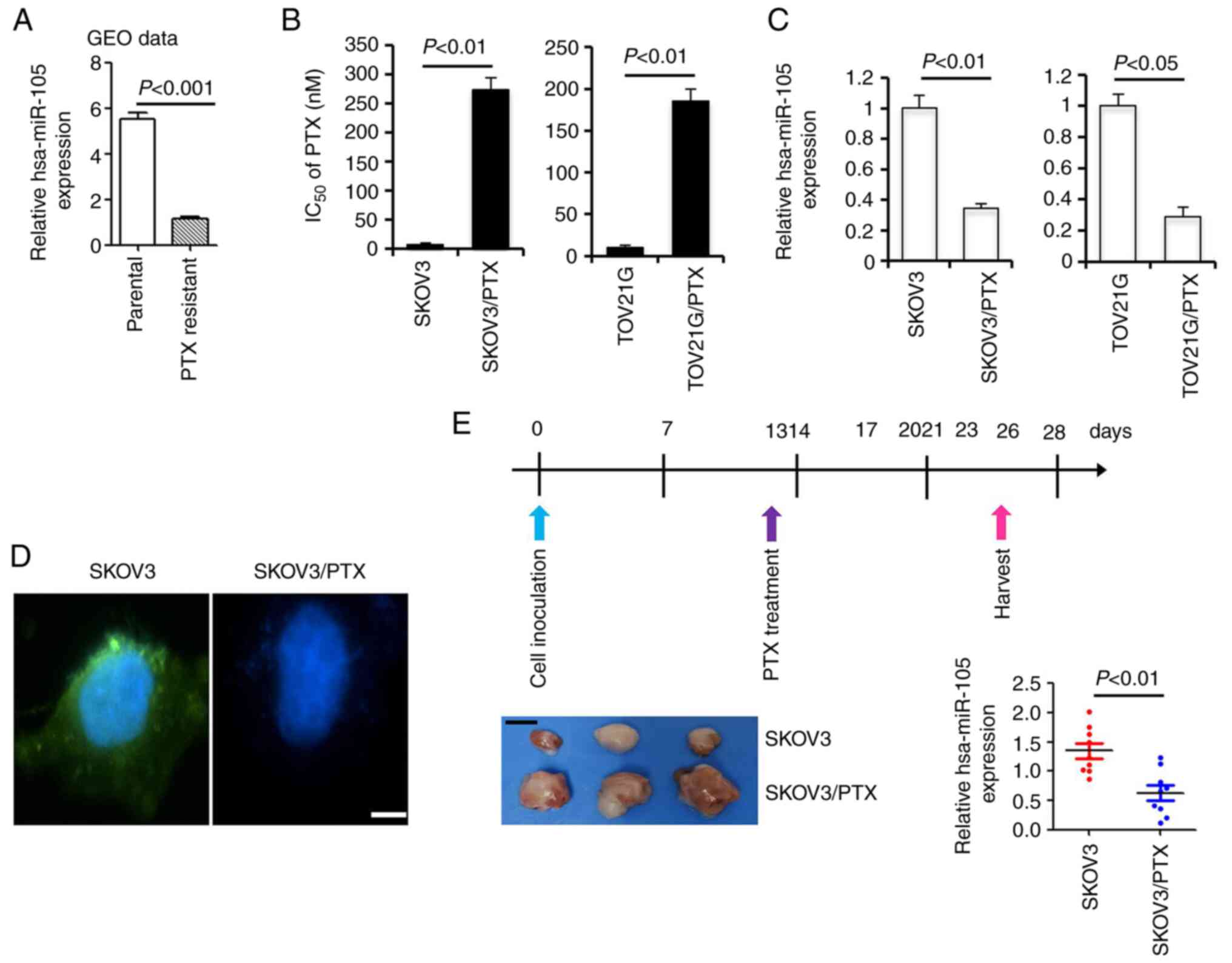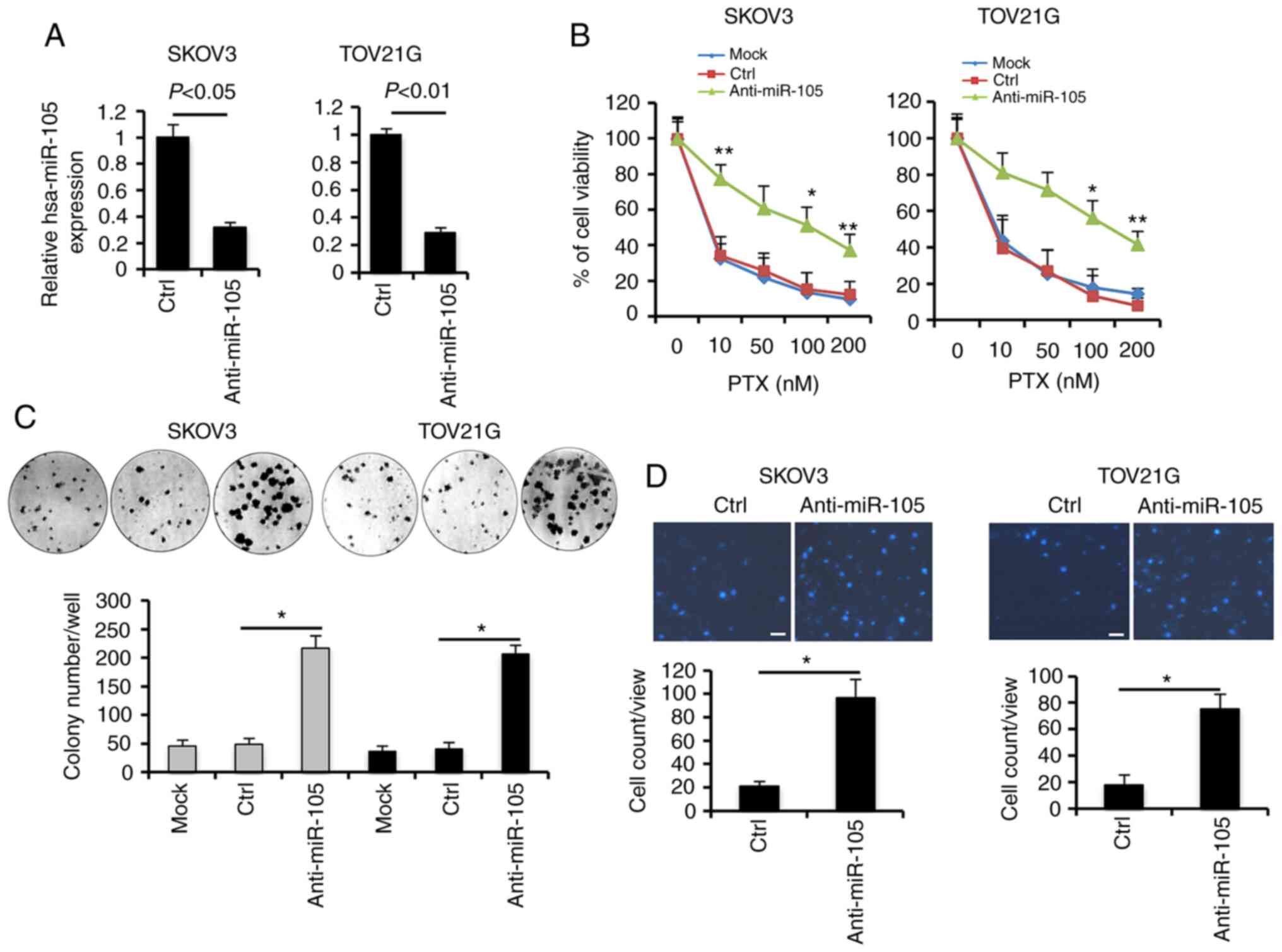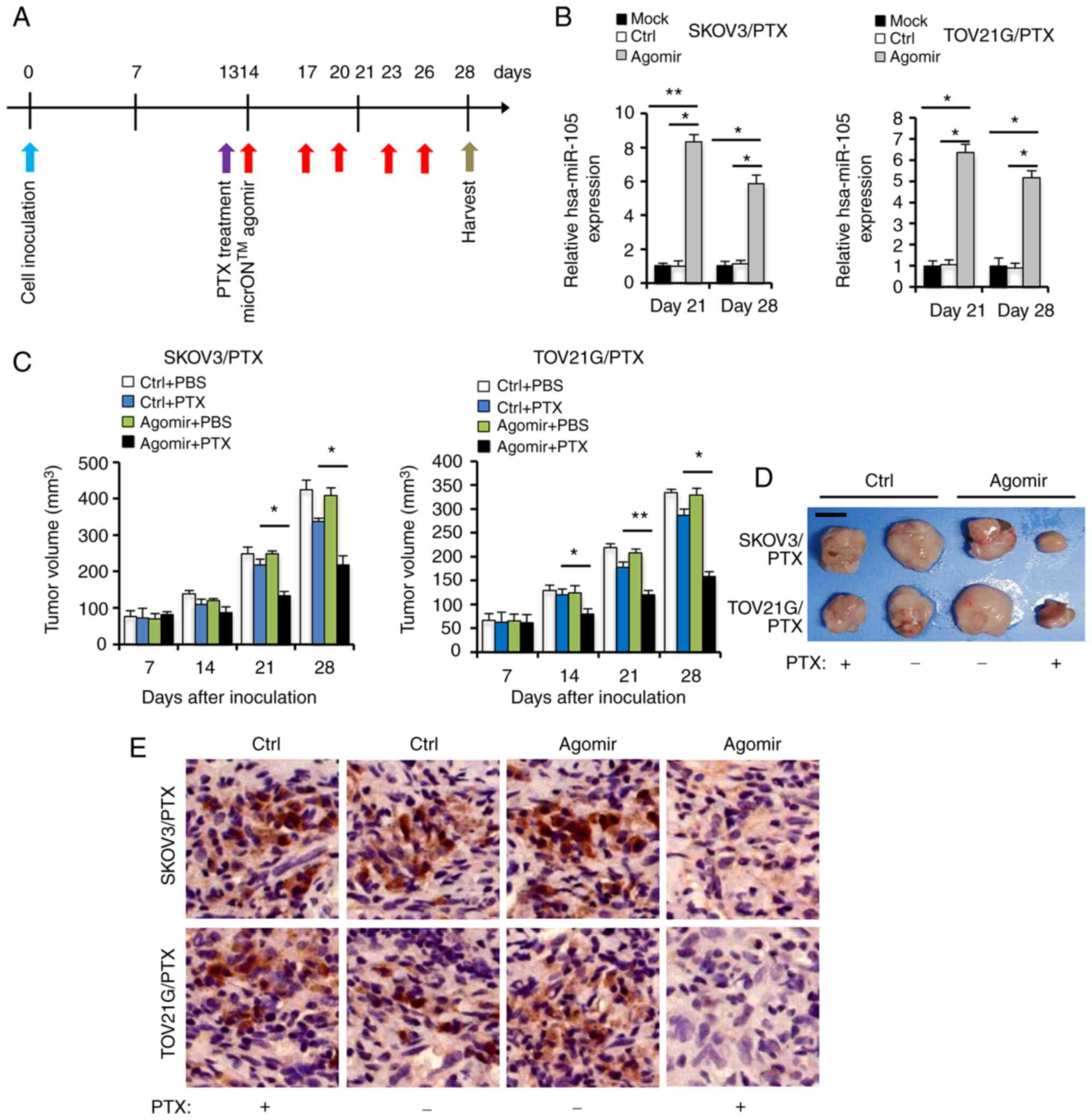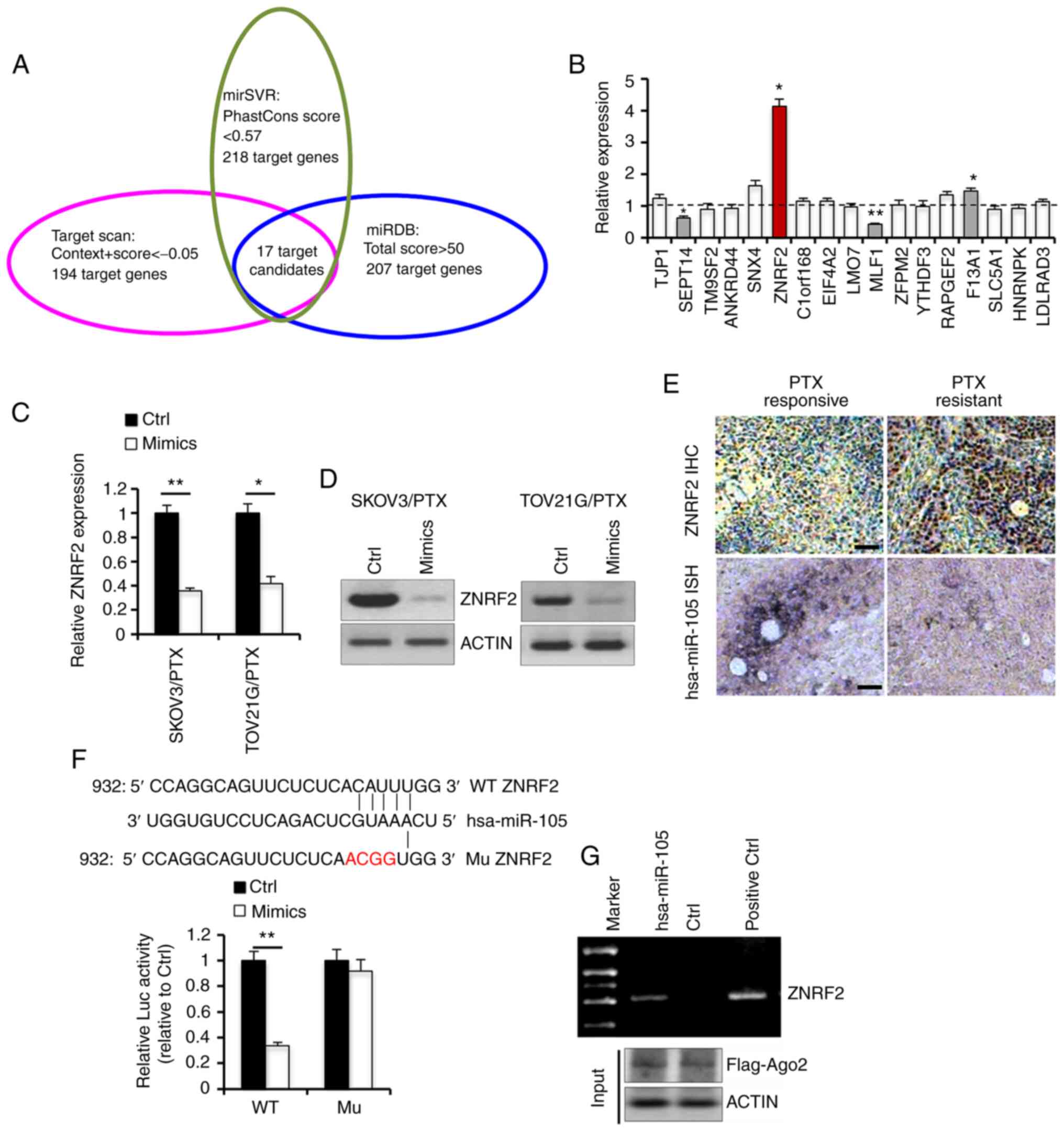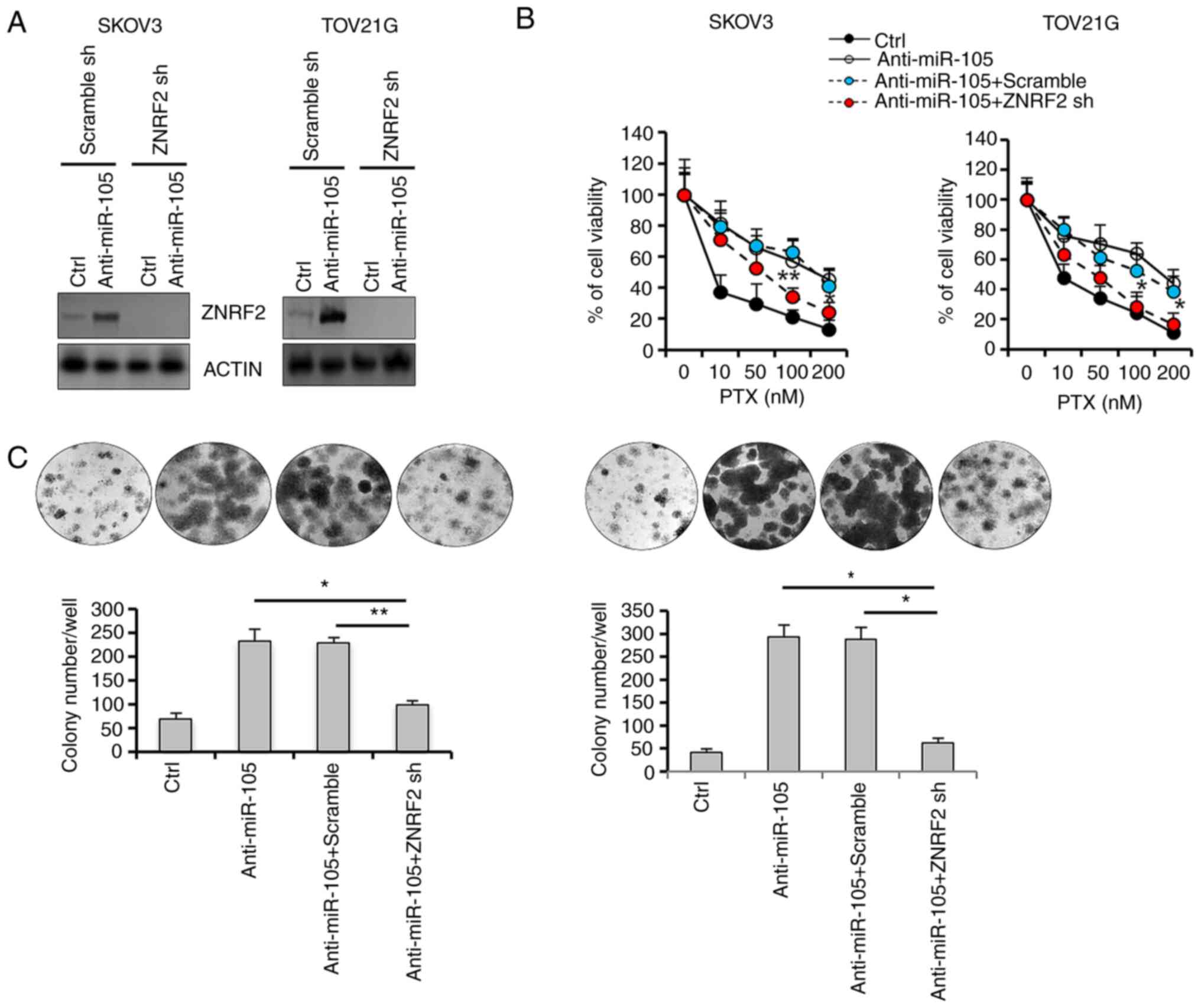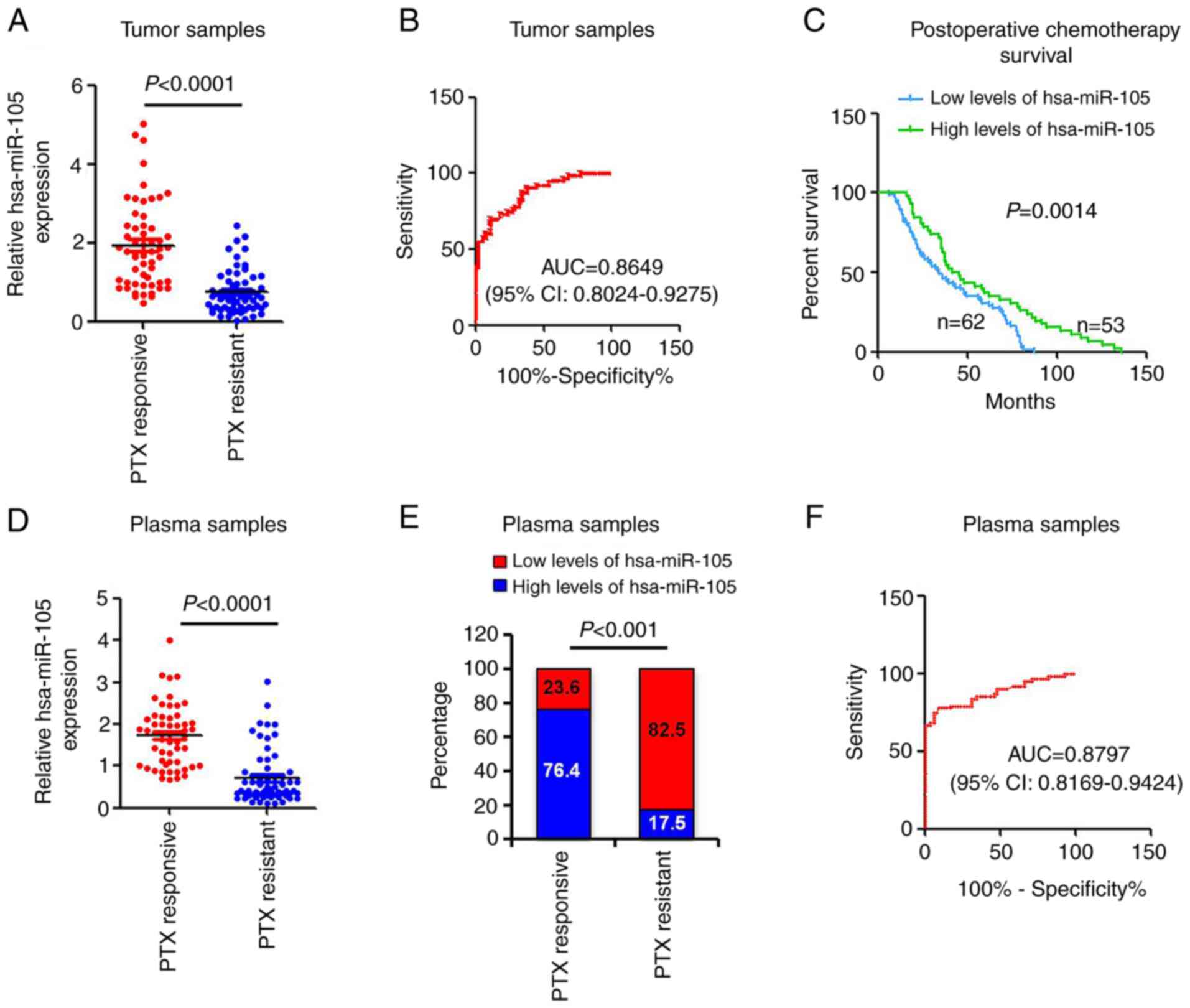|
1
|
Pokhriyal R, Hariprasad R, Kumar L and
Hariprasad G: Chemotherapy resistance in advanced ovarian cancer
patients. Biomark Cancer. 11:1179299X198608152019. View Article : Google Scholar : PubMed/NCBI
|
|
2
|
Sawai T, Miyahara M, Nakajima H, Nakamori
S, Sakai M, Tamada H, Tanigawa T, Yamada N, Nakamura M and Ito M:
The impact of preprocedural hemoglobin A1c on the efficacy of
sirolimus-eluting and paclitaxel-eluting stents. Cardiovasc Interv
Ther. 27:72–83. 2012. View Article : Google Scholar : PubMed/NCBI
|
|
3
|
Siegel RL, Miller KD and Jemal A: Cancer
statistics, 2019. CA Cancer J Clin. 69:7–34. 2019. View Article : Google Scholar : PubMed/NCBI
|
|
4
|
Suh DH, Kim M, Lee KH, Eom KY, Kjeldsen
MK, Mirza MR and Kim JW: Major clinical research advances in
gynecologic cancer in 2017. J Gynecol Oncol. 29:e312018. View Article : Google Scholar : PubMed/NCBI
|
|
5
|
Winter WE III, Maxwell GL, Tian C, Carlson
JW, Ozols RF, Rose PG, Markman M, Armstrong DK, Muggia F and
McGuire WP; Gynecologic Oncology Group Study, : Prognostic factors
for stage III epithelial ovarian cancer: A gynecologic oncology
group study. J Clin Oncol. 25:3621–3627. 2007. View Article : Google Scholar : PubMed/NCBI
|
|
6
|
Liu G, Zhang Q, Li D, Zhang L, Gu Z, Liu
J, Liu G, Yang M, Gu J, Cui X, et al: PD-1 silencing improves
anti-tumor activities of human mesothelin-targeted CAR T cells. Hum
Immunol. 82:130–138. 2021. View Article : Google Scholar : PubMed/NCBI
|
|
7
|
Le Saux O, Dubois B, Stern MH, Terme M,
Tartour E, Classe JM, Chopin N, Trédan O, Caux C and Ray-Coquard I:
Current advances in immunotherapy in ovarian cancer. Bull Cancer.
107:465–473. 2020.(In French). View Article : Google Scholar : PubMed/NCBI
|
|
8
|
Cook SA and Tinker AV: PARP inhibitors and
the evolving landscape of ovarian cancer management: A review.
BioDrugs. 33:255–273. 2019. View Article : Google Scholar : PubMed/NCBI
|
|
9
|
Naskou J, Beiter Y, van Rensburg R,
Honisch E, Rudelius M, Schlensog M, Gottstein J, Walter L, Braicu
EI, Sehouli J, et al: EZH2 loss drives resistance to carboplatin
and paclitaxel in serous ovarian cancers expressing ATM. Mol Cancer
Res. 18:278–286. 2020. View Article : Google Scholar : PubMed/NCBI
|
|
10
|
Vasey PA, Paul J, Birt A, Junor EJ, Reed
NS, Symonds RP, Atkinson R, Graham J, Crawford SM, Coleman R, et
al: Docetaxel and cisplatin in combination as first-line
chemotherapy for advanced epithelial ovarian cancer. Scottish
gynaecological cancer trials group. J Clin Oncol. 17:2069–2080.
1999. View Article : Google Scholar : PubMed/NCBI
|
|
11
|
du Bois A, Luck HJ, Meier W, Adams HP,
Möbus V, Costa S, Bauknecht T, Richter B, Warm M, Schröder W, et
al: A randomized clinical trial of cisplatin/paclitaxel versus
carboplatin/paclitaxel as first-line treatment of ovarian cancer. J
Natl Cancer Inst. 95:1320–1329. 2003. View Article : Google Scholar : PubMed/NCBI
|
|
12
|
Foley OW, Rauh-Hain JA and del Carmen MG:
Recurrent epithelial ovarian cancer: An update on treatment.
Oncology (Williston Park). 27:288–294, 298. 2013.PubMed/NCBI
|
|
13
|
Hennessy BT, Coleman RL and Markman M:
Ovarian cancer. Lancet. 374:1371–1382. 2009. View Article : Google Scholar : PubMed/NCBI
|
|
14
|
Zhang SF, Wang XY, Fu ZQ, Peng QH, Zhang
JY, Ye F, Fu YF, Zhou CY, Lu WG, Cheng XD and Xie X: TXNDC17
promotes paclitaxel resistance via inducing autophagy in ovarian
cancer. Autophagy. 11:225–238. 2015. View Article : Google Scholar : PubMed/NCBI
|
|
15
|
Huh JH, Kim TH, Kim K, Song JA, Jung YJ,
Jeong JY, Lee MJ, Kim YK, Lee DH and An HJ: Dysregulation of
miR-106a and miR-591 confers paclitaxel resistance to ovarian
cancer. Br J Cancer. 109:452–461. 2013. View Article : Google Scholar : PubMed/NCBI
|
|
16
|
Wei L, Sun J, Zhang N, Zheng Y, Wang X, Lv
L, Liu J, Xu Y, Shen Y and Yang M: Noncoding RNAs in gastric
cancer: Implications for drug resistance. Mol Cancer. 19:622020.
View Article : Google Scholar : PubMed/NCBI
|
|
17
|
Marengo B, Pulliero A, Izzotti A and
Domenicotti C: MiRNA regulation of glutathione homeostasis in
cancer initiation, progression and therapy resistance. Microrna.
9:187–197. 2020. View Article : Google Scholar : PubMed/NCBI
|
|
18
|
Li J, Zhang Z, Chen F, Hu T, Peng W, Gu Q
and Sun Y: The diverse oncogenic and tumor suppressor roles of
microRNA-105 in cancer. Front Oncol. 9:5182019. View Article : Google Scholar : PubMed/NCBI
|
|
19
|
Li HY, Liang JL, Kuo YL, Lee HH, Calkins
MJ, Chang HT, Lin FC, Chen YC, Hsu TI, Hsiao M, et al:
MiR-105/93-3p promotes chemoresistance and circulating
miR-105/93-3p acts as a diagnostic biomarker for triple negative
breast cancer. Breast Cancer Res. 19:1332017. View Article : Google Scholar : PubMed/NCBI
|
|
20
|
Kazmierczak D, Jopek K, Sterzynska K,
Ginter-Matuszewska B, Nowicki M, Rucinski M and Januchowski R: The
significance of MicroRNAs expression in regulation of extracellular
matrix and other drug resistant genes in drug resistant ovarian
cancer cell lines. Int J Mol Sci. 21:26192020. View Article : Google Scholar
|
|
21
|
Chai Y, Tan F, Ye S, Liu F and Fan Q:
Identification of core genes and prediction of miRNAs associated
with osteoporosis using a bioinformatics approach. Oncol Lett.
17:468–481. 2019.PubMed/NCBI
|
|
22
|
Pla A, Zhong X and Rayner S: MiRAW: A deep
learning-based approach to predict microRNA targets by analyzing
whole microRNA transcripts. PLoS Comput Biol. 14:e10061852018.
View Article : Google Scholar : PubMed/NCBI
|
|
23
|
Fu Y, Hu D, Qiu J, Xie X, Ye F and Lu WG:
Overexpression of glycogen synthase kinase-3 in ovarian carcinoma
cells with acquired paclitaxel resistance. Int J Gynecol Cancer.
21:439–444. 2011. View Article : Google Scholar : PubMed/NCBI
|
|
24
|
Sun NK, Huang SL, Chang TC and Chao CC:
TLR4 and NFKB signaling is critical for taxol resistance in ovarian
carcinoma cells. J Cell Physiol. 233:2489–2501. 2018. View Article : Google Scholar : PubMed/NCBI
|
|
25
|
Niyazi M, Niyazi I and Belka C: Counting
colonies of clonogenic assays by using densitometric software.
Radiat Oncol. 2:42007. View Article : Google Scholar : PubMed/NCBI
|
|
26
|
Zhao G, Li Y and Wang T: Potentiation of
docetaxel sensitivity by miR-638 via regulation of STARD10 pathway
in human breast cancer cells. Biochem Biophys Res Commun.
487:255–261. 2017. View Article : Google Scholar : PubMed/NCBI
|
|
27
|
Fu Z, Wang C, Chen Y, Zhang X, Wang X and
Xie X: Down-regulation of UTP23 promotes paclitaxel resistance and
predicts poorer prognosis in ovarian cancer. Pathol Res Pract.
215:1526252019. View Article : Google Scholar : PubMed/NCBI
|
|
28
|
Li X, Lu Y, Chen Y, Lu W and Xie X:
MicroRNA profile of paclitaxel-resistant serous ovarian carcinoma
based on formalin-fixed paraffin-embedded samples. BMC Cancer.
13:2162013. View Article : Google Scholar : PubMed/NCBI
|
|
29
|
Zhang LL, Ma J, Yang B, Zhao J, Yan BY,
Zhang YQ and Li W: Interference with lactate metabolism by
mmu-miR-320-3p via negatively regulating GLUT3 signaling in mouse
Sertoli cells. Cell Death Dis. 9:9642018. View Article : Google Scholar : PubMed/NCBI
|
|
30
|
Dong YS, Hou WG, Li Y, Liu DB, Hao GZ,
Zhang HF, Li JC, Zhao J, Zhang S, Liang GB and Li W: Unexpected
requirement for a binding partner of the syntaxin family in
phagocytosis by murine testicular Sertoli cells. Cell Death Differ.
23:787–800. 2016. View Article : Google Scholar : PubMed/NCBI
|
|
31
|
Livak KJ and Schmittgen TD: Analysis of
relative gene expression data using real-time quantitative PCR and
the 2(-Delta Delta C(T)) method. Methods. 25:402–408. 2001.
View Article : Google Scholar : PubMed/NCBI
|
|
32
|
He K, Qu H, Wang H, Zhang S, Qian XH and
Li W: Regulated and functional expression of the corepressor MTA3
in rodent testis. Endocrinology. 157:4400–4410. 2016. View Article : Google Scholar : PubMed/NCBI
|
|
33
|
Zhang C, Lai JH, Hu B, Zhang S, Zhao J and
Li W: A chromatin modifier regulates Sertoli cell response to
mono-(2-ethylhexyl) phthalate (MEHP) via tissue inhibitor of
metalloproteinase 2 (TIMP2) signaling. Biochim Biophys Acta.
1839:1170–1182. 2014. View Article : Google Scholar : PubMed/NCBI
|
|
34
|
Zhang S, Li W, Zhu C, Wang X, Li Z, Zhang
J, Zhao J, Hu J, Li T and Zhang Y: Sertoli cell-specific expression
of metastasis-associated protein 2 (MTA2) is required for
transcriptional regulation of the follicle-stimulating hormone
receptor (FSHR) gene during spermatogenesis. J Biol Chem.
287:40471–40483. 2012. View Article : Google Scholar : PubMed/NCBI
|
|
35
|
Lian SL, Li S, Abadal GX, Pauley BA,
Fritzler MJ and Chan EK: The C-terminal half of human Ago2 binds to
multiple GW-rich regions of GW182 and requires GW182 to mediate
silencing. RNA. 15:804–813. 2009. View Article : Google Scholar : PubMed/NCBI
|
|
36
|
Hou J, Lin L, Zhou W, Wang Z, Ding G, Dong
Q, Qin L, Wu X, Zheng Y, Yang Y, et al: Identification of miRNomes
in human liver and hepatocellular carcinoma reveals miR-199a/b-3p
as therapeutic target for hepatocellular carcinoma. Cancer Cell.
19:232–243. 2011. View Article : Google Scholar : PubMed/NCBI
|
|
37
|
Xiao Q, Yang Y, An Q and Qi Y:
MicroRNA-100 suppresses human osteosarcoma cell proliferation and
chemo-resistance via ZNRF2. Oncotarget. 8:34678–34686. 2017.
View Article : Google Scholar : PubMed/NCBI
|
|
38
|
Wang L and Zhang L: Circulating exosomal
miRNA as diagnostic biomarkers of neurodegenerative diseases. Front
Mol Neurosci. 13:532020. View Article : Google Scholar : PubMed/NCBI
|
|
39
|
Shen Z, Zhou R, Liu C, Wang Y, Zhan W,
Shao Z, Liu J, Zhang F, Xu L, Zhou X, et al: MicroRNA-105 is
involved in TNF-α-related tumor microenvironment enhanced
colorectal cancer progression. Cell Death Dis. 8:32132017.
View Article : Google Scholar : PubMed/NCBI
|
|
40
|
Jin X, Yu Y, Zou Q, Wang M, Cui Y, Xie J
and Wang Z: MicroRNA-105 promotes epithelial-mesenchymal transition
of nonsmall lung cancer cells through upregulating Mcl-1. J Cell
Biochem. 120:5880–5888. 2019. View Article : Google Scholar : PubMed/NCBI
|
|
41
|
Zhou W, Fong MY, Min Y, Somlo G, Liu L,
Palomares MR, Yu Y, Chow A, O'Connor ST, Chin AR, et al:
Cancer-secreted miR-105 destroys vascular endothelial barriers to
promote metastasis. Cancer Cell. 25:501–515. 2014. View Article : Google Scholar : PubMed/NCBI
|
|
42
|
Zhou GQ, Han F, Shi ZL, Yu L, Li XF, Yu C,
Shen CL, Wan DW, Zhu XG, Li R and He SB: DNMT3A-mediated
down-regulation of microRNA-105 promotes gastric cancer cell
proliferation. Eur Rev Med Pharmacol Sci. 21:3377–3383.
2017.PubMed/NCBI
|
|
43
|
Honeywell DR, Cabrita MA, Zhao H,
Dimitroulakos J and Addison CL: MiR-105 inhibits prostate tumour
growth by suppressing CDK6 levels. PLoS One. 8:e705152013.
View Article : Google Scholar : PubMed/NCBI
|
|
44
|
Cheng FHC, Lin HY, Hwang TW, Chen YC,
Huang RL, Chang CB, Yang W, Lin RI, Lin CW, Chen GCW, et al: E2F6
functions as a competing endogenous RNA, and transcriptional
repressor, to promote ovarian cancer stemness. Cancer Sci.
110:1085–1095. 2019. View Article : Google Scholar : PubMed/NCBI
|
|
45
|
Braga EA, Loginov VI, Filippova EA,
Burdennyi AM, Pronina IV, Kazubskaya TP, Khodyrev DS, Utkin DO,
Kushlinskii DN, Adamyan LV and Kuslinskii NE: Diagnostic value of a
group of MicroRNA genes hypermethylated in ovarian carcinoma. Bull
Exp Biol Med. 166:253–256. 2018. View Article : Google Scholar : PubMed/NCBI
|
|
46
|
Loriot A, Van Tongelen A, Blanco J,
Klaessens S, Cannuyer J, van Baren N, Decottignies A and De Smet C:
A novel cancer-germline transcript carrying pro-metastatic miR-105
and TET-targeting miR-767 induced by DNA hypomethylation in tumors.
Epigenetics. 9:1163–1171. 2014. View Article : Google Scholar : PubMed/NCBI
|
|
47
|
Yan W, Wu X, Zhou W, Fong MY, Cao M, Liu
J, Liu X, Chen CH, Fadare O, Pizzo DP, et al: Cancer-cell-secreted
exosomal miR-105 promotes tumour growth through the MYC-dependent
metabolic reprogramming of stromal cells. Nat Cell Biol.
20:597–609. 2018. View Article : Google Scholar : PubMed/NCBI
|
|
48
|
Ji Q, Xu X, Xu Y, Fan Z, Kang L, Li L,
Liang Y, Guo J, Hong T, Li Z, et al: MiR-105/Runx2 axis mediates
FGF2-induced ADAMTS expression in osteoarthritis cartilage. J Mol
Med (Berl). 94:681–694. 2016. View Article : Google Scholar : PubMed/NCBI
|
|
49
|
Bui-Nguyen TM, Pakala SB, Sirigiri RD, Xia
W, Hung MC, Sarin SK, Kumar V, Slagle BL and Kumar R: NF-kappaB
signaling mediates the induction of MTA1 by hepatitis B virus
transactivator protein HBx. Oncogene. 29:1179–1189. 2010.
View Article : Google Scholar : PubMed/NCBI
|
|
50
|
Hoxhaj G, Caddye E, Najafov A, Houde VP,
Johnson C, Dissanayake K, Toth R, Campbell DG, Prescott AR and
MacKintosh C: The E3 ubiquitin ligase ZNRF2 is a substrate of
mTORC1 and regulates its activation by amino acids. Elife.
5:e122782016. View Article : Google Scholar : PubMed/NCBI
|
|
51
|
Yang M, Zhai Z, Zhang Y and Wang Y:
Clinical significance and oncogene function of long noncoding RNA
HAGLROS overexpression in ovarian cancer. Arch Gynecol Obstet.
300:703–710. 2019. View Article : Google Scholar : PubMed/NCBI
|
|
52
|
Musa F, Alard A, David-West G, Curtin JP,
Blank SV and Schneider RJ: Dual mTORC1/2 inhibition as a novel
strategy for the resensitization and treatment of
platinum-resistant ovarian cancer. Mol Cancer Ther. 15:1557–1567.
2016. View Article : Google Scholar : PubMed/NCBI
|
|
53
|
Cui Z, Luo Z, Lin Z, Shi L, Hong Y and Yan
C: Long non-coding RNA TTN-AS1 facilitates tumorigenesis of
papillary thyroid cancer through modulating the miR-153-3p/ZNRF2
axis. J Gene Med. 21:e30832019. View Article : Google Scholar : PubMed/NCBI
|
|
54
|
Ribeiro JR, Schorl C, Yano N, Romano N,
Kim KK, Singh RK and Moore RG: HE4 promotes collateral resistance
to cisplatin and paclitaxel in ovarian cancer cells. J Ovarian Res.
9:282016. View Article : Google Scholar : PubMed/NCBI
|















